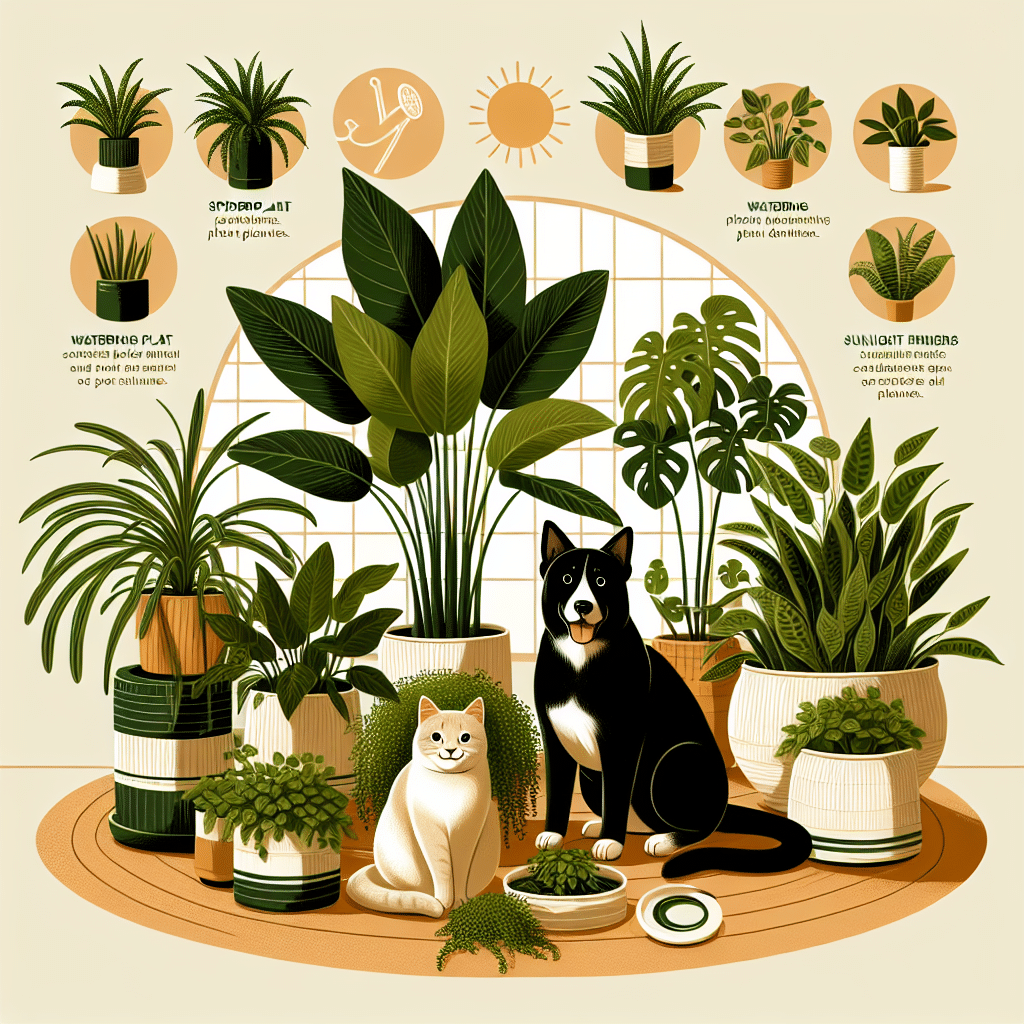Beginner-Friendly Care Instructions for Pet-Safe Houseplants
When it comes to incorporating houseplants into your home, the safety of your pets should always be a primary consideration. Not only do houseplants enhance your living space, but they also improve air quality. Here, we delve into beginner-friendly care instructions for a selection of pet-safe houseplants. These plants are easy to care for and bring lush greenery into your home without posing risks to your furry friends.
1. Spider Plant (Chlorophytum comosum)
Light Requirements: Spider plants thrive in bright, indirect sunlight but can also tolerate low-light conditions.
Watering: Allow the top inch of soil to dry out before watering. During the growing season (spring and summer), water more frequently, about once a week.
Humidity: They appreciate moderate humidity but can adapt to various levels. If your home is very dry, occasional misting can be beneficial.
Fertilization: Fertilize with a balanced liquid fertilizer every 4-6 weeks during the growing season. Cut back in the fall and winter.
Propagation: Spider plants are prolific and can be easily propagated through their “pups,” or baby plants, which can be repotted once they develop roots.
2. Boston Fern (Nephrolepis exaltata)
Light Requirements: Boston ferns prefer low to medium indirect light. Direct sunlight can scorch the fronds.
Watering: Keep the soil consistently moist but not soggy. Aim to water the fern once the top layer of the soil feels dry.
Humidity: These ferns love high humidity. Regular misting or placing a humidifier nearby is beneficial. They can thrive in a bathroom or kitchen, where humidity levels are higher.
Fertilization: Apply a diluted liquid fertilizer every 4-6 weeks during the spring and summer months.
Pruning: Remove any dead fronds to keep the plant healthy and encourage new growth.
3. Parlor Palm (Chamaedorea elegans)
Light Requirements: The Parlor Palm is well-suited for low light. Bright indirect light will encourage more growth but it can adapt to shadier spots.
Watering: Water when the top inch of soil feels dry. Be careful not to overwater, as this palm is susceptible to root rot.
Humidity: It thrives in a humid environment but can tolerate lower levels. Misting can help, especially in winter when indoor air can be dry.
Fertilization: Feed with a balanced houseplant fertilizer every month during the growing season.
Grooming: Wipe leaves with a damp cloth to remove dust, which allows the plant to absorb more light.
4. Areca Palm (Dypsis lutescens)
Light Requirements: Areca palms prefer bright, indirect light but can also thrive in filtered sunlight.
Watering: Keep the soil evenly moist during the growing season. Allow the topsoil to dry slightly between waterings in the winter.
Humidity: This palm loves humidity, making it ideal for bathrooms or kitchens. Regular misting or a pebble tray with water can help maintain moisture.
Fertilization: Use a diluted, balanced fertilizer every two to four weeks in the spring and summer.
Repotting: Areca palms benefit from being repotted every couple of years to refresh the soil.
5. Calathea (Calathea spp.)
Light Requirements: Calatheas prefer low to medium indirect light. Avoid direct sunlight, as it can cause the leaves to burn.
Watering: Keep the soil evenly moist but not soggy. Water when the top inch feels dry; Calatheas are sensitive to low humidity and dry soil.
Humidity: High humidity is essential for Calathea. Misting the leaves or using a humidifier can prevent leaf curling and browning.
Fertilization: Fertilize monthly during the growing season with a balanced, water-soluble fertilizer diluted to half strength.
Leaf Care: Dust the leaves regularly to allow for optimal photosynthesis.
6. African Violet (Saintpaulia)
Light Requirements: African violets thrive in bright, indirect light, made ideal for a windowsill that is not in direct sun.
Watering: Water from the bottom to avoid wetting the leaves, which can lead to crown rot. Allow the soil to dry slightly before the next watering.
Humidity: Moderate humidity is best. If your home is dry, consider placing a humidifier nearby.
Fertilization: A balanced fertilizer every 4-6 weeks during the growing season promotes healthy blooms.
Pruning: Pinch off dead flowers and yellowing leaves to encourage new growth.
7. Bamboo Palm (Chamaedorea seifrizii)
Light Requirements: Bamboo palms prefer partial shade or indirect light, making them perfect for indoors.
Watering: Allow the top inch of soil to dry out between waterings. In the winter, reduce watering.
Humidity: This palm enjoys high humidity, so misting or having it in a humid area of the home is ideal.
Fertilization: Feed with a liquid fertilizer every month during the growing season, ensuring to dilute appropriately.
Pest Management: Regularly check for spider mites and wipe the leaves if necessary.
General Care Tips for Pet-Safe Houseplants
-
Location: Keep plants in locations that are inaccessible to pets, like high shelves or hanging planters, as a precaution.
-
Soil Quality: Choose high-quality potting soil to promote healthy growth and help prevent diseases.
-
Observation: Regularly check your plants for signs of pests or disease, such as yellowing leaves or discolored spots.
-
Water Management: Always use pots with drainage holes to prevent overwatering and root rot.
-
Education: Learn more about the specific care needs of each plant. Different species may have unique requirements regarding light, humidity, and soil.
By choosing pet-safe houseplants and following simple care instructions, you can enjoy the benefits of green living without compromising your pets’ safety. Adopting a green lifestyle will not only beautify your space but also foster a healthier environment for both you and your furry companions.
